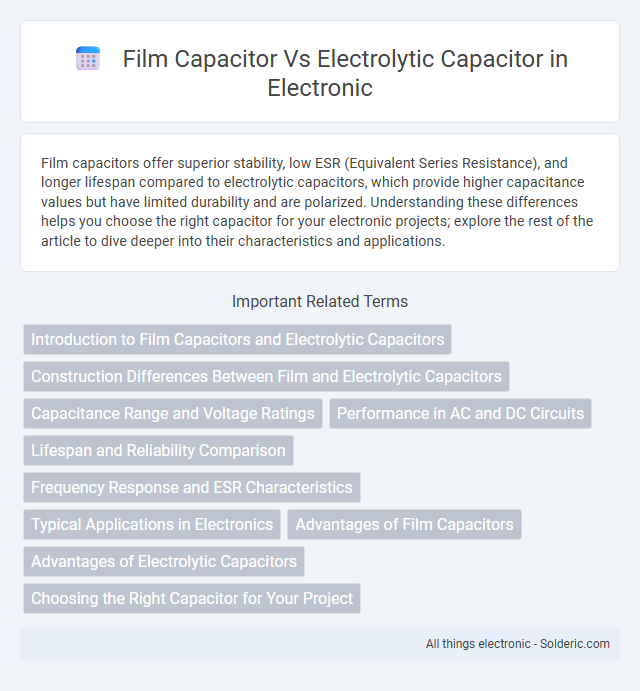Film capacitors offer superior stability, low ESR (Equivalent Series Resistance), and longer lifespan compared to electrolytic capacitors, which provide higher capacitance values but have limited durability and are polarized. Understanding these differences helps you choose the right capacitor for your electronic projects; explore the rest of the article to dive deeper into their characteristics and applications.
Comparison Table
| Feature | Film Capacitor | Electrolytic Capacitor |
|---|---|---|
| Dielectric Material | Plastic Film (e.g., Mylar, Polypropylene) | Aluminum or Tantalum Oxide Layer |
| Capacitance Range | 1 pF to 100 uF | 1 uF to 10,000 uF |
| Voltage Rating | Up to 1000 V or higher | Typically up to 500 V |
| Polarization | Non-polarized | Polarized |
| Equivalent Series Resistance (ESR) | Low ESR | Higher ESR |
| Leakage Current | Very Low Leakage | Higher Leakage |
| Temperature Stability | Excellent Stability | Moderate to Poor Stability |
| Frequency Response | Good for High Frequency | Limited High-Frequency Performance |
| Physical Size | Larger for Same Capacitance | Smaller for High Capacitance |
| Common Applications | Signal filtering, audio circuits, timing | Power supply filtering, decoupling, bulk storage |
| Lifespan | Longer lifespan & more reliable | Shorter lifespan, electrolyte drying |
Introduction to Film Capacitors and Electrolytic Capacitors
Film capacitors utilize a thin plastic film as the dielectric, offering high stability, low inductance, and excellent frequency response, making them ideal for precision and high-frequency applications. Electrolytic capacitors use an electrolyte-soaked paper as the dielectric, providing high capacitance values in compact sizes but with higher leakage current and lower tolerance. Your choice depends on the application's requirements for capacitance, voltage rating, and performance characteristics such as stability and lifespan.
Construction Differences Between Film and Electrolytic Capacitors
Film capacitors consist of thin plastic film dielectric layers separated by metal foil electrodes, offering a stable and non-polarized structure with lower equivalent series resistance (ESR). Electrolytic capacitors use an aluminum or tantalum anode with a liquid or solid electrolyte serving as the cathode, creating a polarized device prone to higher ESR and leakage currents. The solid construction of film capacitors enhances longevity and performance in high-frequency applications, whereas electrolytic capacitors provide higher capacitance values in a smaller volume due to their unique electrolyte-based design.
Capacitance Range and Voltage Ratings
Film capacitors typically offer capacitance values ranging from a few picofarads to several microfarads and support voltage ratings up to several hundred volts, making them ideal for high-frequency and high-voltage applications. Electrolytic capacitors provide much higher capacitance values, commonly from 1 microfarad to several thousand microfarads, with voltage ratings usually between 6.3V and 450V, suited for power supply filtering and energy storage. The choice between film and electrolytic capacitors depends on the required capacitance magnitude and operating voltage, with film capacitors excelling in stability and lower parasitic properties at moderate voltages.
Performance in AC and DC Circuits
Film capacitors exhibit superior performance in AC circuits due to their low equivalent series resistance (ESR) and inductance, resulting in minimal energy loss and stable capacitance over a wide frequency range. Electrolytic capacitors provide higher capacitance values but are more suitable for DC circuits because of their polarized nature and higher ESR, which limits their effectiveness in high-frequency AC applications. In DC circuits, electrolytic capacitors excel in bulk energy storage, whereas film capacitors are preferred for applications requiring long-term reliability and low dielectric absorption.
Lifespan and Reliability Comparison
Film capacitors typically offer a longer lifespan and higher reliability compared to electrolytic capacitors due to their solid dielectric materials, which resist degradation over time and temperature fluctuations. Electrolytic capacitors, while generally providing higher capacitance values, tend to have shorter lifespans because of their liquid electrolyte that evaporates or dries out, leading to performance decline and potential failure. In high-reliability applications requiring stable capacitance and low equivalent series resistance (ESR), film capacitors are often preferred for their durability and consistent performance.
Frequency Response and ESR Characteristics
Film capacitors exhibit superior frequency response with low equivalent series resistance (ESR), making them ideal for high-frequency applications and signal filtering where minimal energy loss is crucial. Electrolytic capacitors generally have higher ESR and limited frequency response, causing increased losses and less efficient performance in high-frequency circuits. For your designs requiring stability and low distortion at higher frequencies, choosing film capacitors ensures improved reliability and performance over electrolytic types.
Typical Applications in Electronics
Film capacitors are commonly used in applications requiring high-frequency stability, low ESR, and reliability, such as signal processing, audio equipment, and precision timing circuits. Electrolytic capacitors are preferred for power supply filtering, decoupling, and bulk energy storage due to their high capacitance values and cost-effectiveness. Your choice depends on the circuit requirements, with film capacitors excelling in precision and longevity while electrolytic capacitors offer larger capacitance in compact sizes.
Advantages of Film Capacitors
Film capacitors offer superior stability, low dielectric absorption, and excellent frequency characteristics compared to electrolytic capacitors. They have a longer lifespan due to their non-polarized construction and resistance to moisture and heat. These capacitors are ideal for high-precision applications such as audio equipment, power supplies, and timing circuits where reliability and performance are critical.
Advantages of Electrolytic Capacitors
Electrolytic capacitors offer high capacitance values in a compact size, making them ideal for power supply filtering and energy storage in electronic circuits. Their cost-effectiveness and availability in a wide range of voltages provide versatility for diverse applications. If your project requires large capacitance with minimal space, electrolytic capacitors present a practical solution.
Choosing the Right Capacitor for Your Project
Film capacitors offer superior stability, low ESR, and long lifespan, making them ideal for high-frequency and precision applications. Electrolytic capacitors provide higher capacitance values at a lower cost, suited for power supply filtering and bulk energy storage. Consider your project's voltage ratings, tolerance requirements, and frequency response to select the capacitor that ensures optimal performance and reliability.
film capacitor vs electrolytic capacitor Infographic

 solderic.com
solderic.com